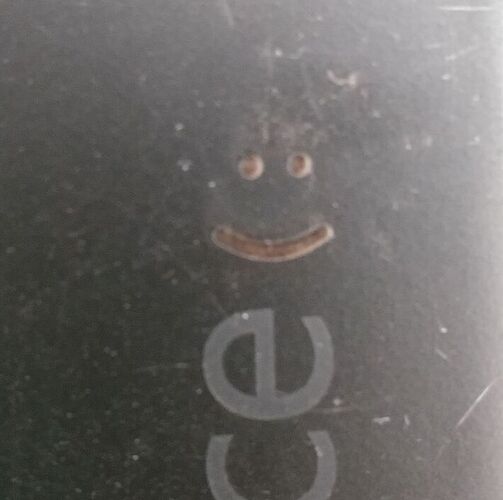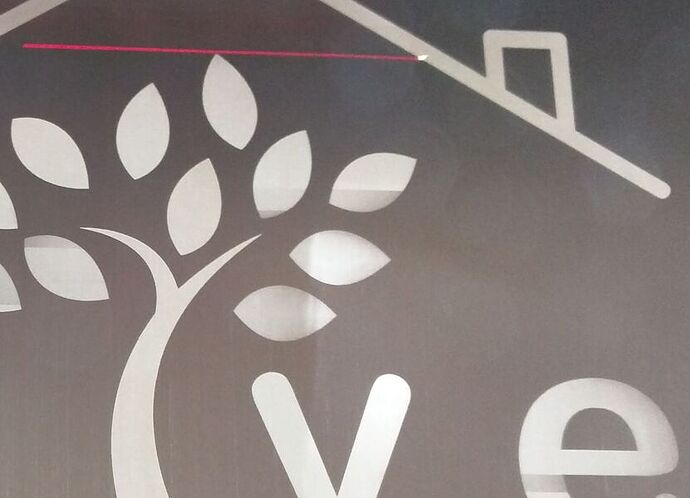Welcome @curt! You’ll love what it does on anodized. 
I can’t wait. I’m a pretty impatient person to begin with, now it’s just compounded. 
And my offer for AA parts is good for anybody that has a pre release/beta machine that wants to work with some.
Yeah, one thing we have all experienced is a hard lesson in patience!
Happy to see someone else got a glowforge for scales 
Were the settings that you used for this posted? I might have missed them, but I’m really curious. Looks great!
45% / 225 IPM.
Love your show! Huge Fan!
Thanks so much for the settings and for liking the videos! 
Ah you made it! welcome to the forums!
Yeah, great channel and fun to watch! (And learn)
I think the Surfaces are painted (wet paint, powdered paint, some other kind, I don’t know). Here’s a test I did on my old Surface Pro 2… (not the greatest photo, I’ll take a better one if you want)
I don’t remember the settings or anything helpful like that.
I think I did that the same day I engraved the glass of my friend’s Nexus 6P. ![]()
(“1440” as a reminder that there are only so many minutes in a day and not to waste them)
I get the impression that the dye is just being bleached.[quote=“dwardio, post:38, topic:4542”]
Yes, as are all Apple laptops and iPhones.
[/quote]
The iPhone 5c case is plastic (polycarbonate).
Here’s a shot of the anodized aluminum lid of a Samsung laptop that I engraved for another friend. Sorry for the crop, I don’t wanna show the whole logo for privacy reasons - I know it’s somewhat silly, but that’s just the way I am.
As you can see, there are some odd gradients in the engrave, especially in areas where the width of the engrave changed dramatically. It’s a cool looking effect, but since it was unintentional it’s very bad and shouldn’t be there. This was a early project of mine*, and the gradients had appeared on my test samples as well. To hide my shame I just ran the areas with gradients multiple times until it looked uniform. This photo was actually taken during one of those do-overs.
*I think the cause of the problem might be a mismatch between the laser’s ramp-up and the speed at which I was engraving. At the time, I was basically doing all engraving at “100%” speed (2.8m/sec, supposedly) because that’s what I thought you were supposed to do. I’ve since learned that ~30% seems to be the max usable speed for consistent results, but I haven’t done any more anodized aluminum since then. Trotec tech support wasn’t helpful in resolving the issue.
I have a client with nearly 30 Surfaces and more than a half dozen iPads that are in the field.
Once GF  arrives, I will be engraving the company info and device name on the borders. This will allow me to ask them which device they have without having to dig up the settings screen to just start the support.
arrives, I will be engraving the company info and device name on the borders. This will allow me to ask them which device they have without having to dig up the settings screen to just start the support.
It was good to see that someone had done the lasering on mobile devices and especially on the glass. 
Oops, I actually intended for the image to show that it didn’t work too well. But I was also thinking about the way it looks, not how durable/functional it would be. I guess it’s actually pretty good if you’re looking for an indelible mark, which it sounds like you will be.
I was (and still am) a little nervous about engraving magnesium. If it starts on fire I don’t know what your options would be… maybe pull it out, drop it in a waiting bucket of sand, and carry the bucket outside and waiting for it to burn out (all without blinding yourself)? LOL
I was foolhardy enough to risk it, but…
Not sure if MS will do it, but we know apple phones/tablets are laserable on the back at least, since that is a no-cost option when you order them…
Magnesium is similar to aluminum or other metals, in that a CO2 laser won’t affect it, unless you are etching away an anodized surface, paint, or marking with Cermark. It would most likely fall under the “Painted Metals” category on Epilog’s compatibility chart: Laserable Material Compatibility
Do you know that to be true from experience or believe it to be true from research? Not being a dick, but the potential for catastrophe if it’s not correct is huge - not just ruining a device, but creating a fire that can’t be readily extinguished.
I do ipads/iphones all the time. But I’m not sure if the laser might cause heat that’s sufficient for a flash point for magnesium. If it won’t then that would be great because I have a few Surface units I’d like to engrave but I’m unwilling to try unless I know that it is safe to do so. Usually I’m willing to try new things but I draw the line at things that might cause a fire of the nature burning magnesium produces.
The units are in Otterbox Defenders.
Construction workers are brutal on high tech devices.
So we need to separate the “can it cut/engrave” from can it heat it enough to light it on fire. Those are very different things. It absolutely cannot cut or engrave magnesium itself. Yes, you can light magnesium on fire with light (I mean who hasn’t with a magnifying glass in high school?) so enough concentrated light and small enough thermal mass with enough surface area and yep! Now the autoignition temperature of magnesium ribbon (likely thinner than your part) is 473C (883F) which is pretty damned hot. Now you likely have a magnesium alloy which is a whole other kettle of fish, and may be higher or lower temperature depending on the compound. Here is an article on the basic ignition of magnesium under different conditions. It turns out they do cut magnesium sheets with lasers, but typically with an argon blanket (similar to MIG or TIG welding Mg)
At the link I posted above, Epilog specifically lists magnesium as a laser engrave-able metal, using a fiber laser. If engraving magnesium posed an issue, they would not include it. FOBA also lists magnesium as an engrave-able.
Check out this link. Near the end it is stated that in order to ignite, magnesium must be brought to near its melting point (1200F) and the heat source must be maintained for several minutes. https://www.fire.tc.faa.gov/2007Conference/files/Materials_Fire_Safety/WedAM/GwynneMagnesium/GwynneMagnesiumPres.pdf
Cool. Thanks. The fiber laser Epilog has is different (and way more expensive  ) than I have (CO2 lasers). But the ignition info is helpful.
) than I have (CO2 lasers). But the ignition info is helpful.
I want to see @wesleyjames get that motorcycle thru the pass-thru ![]()


